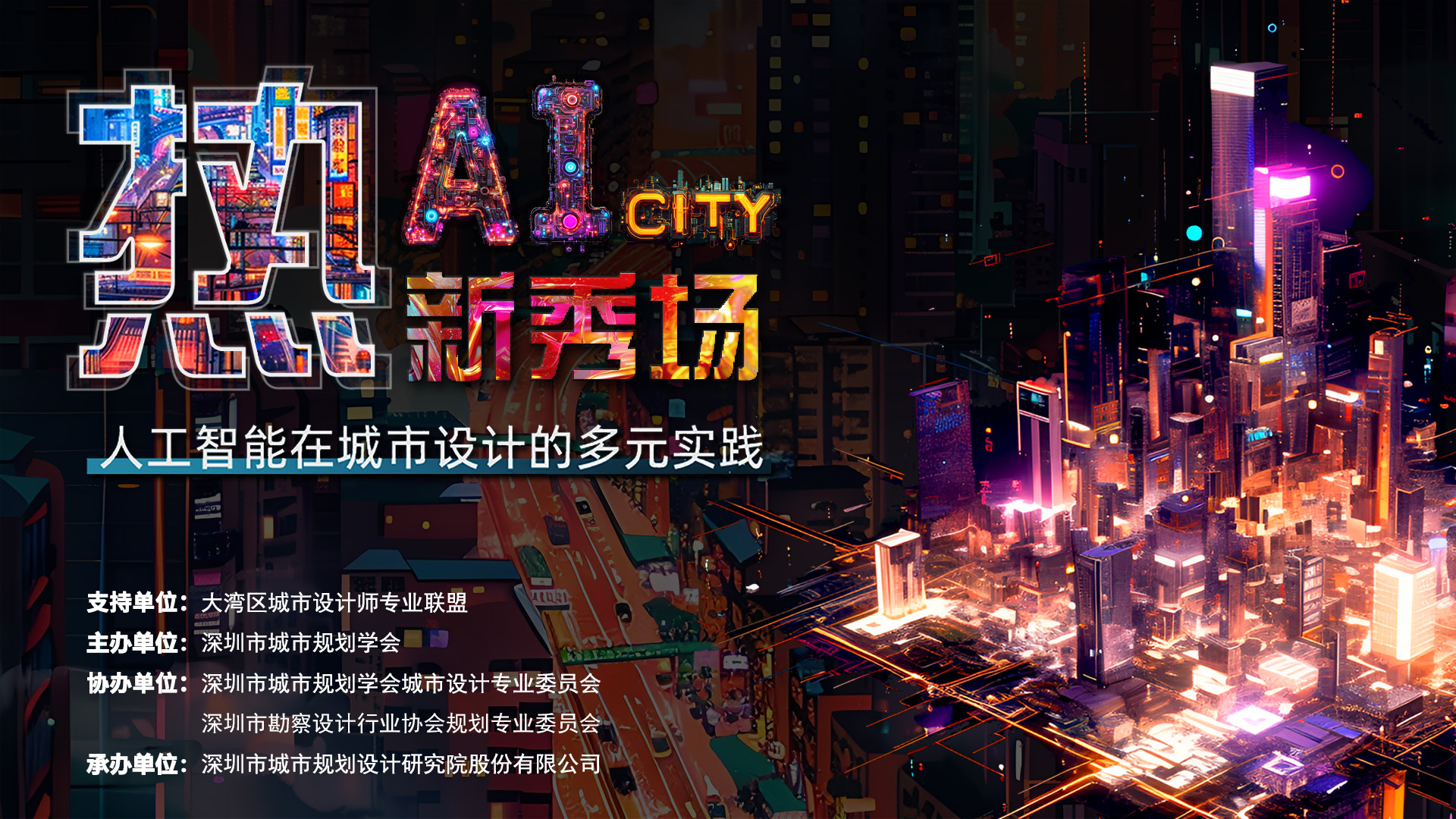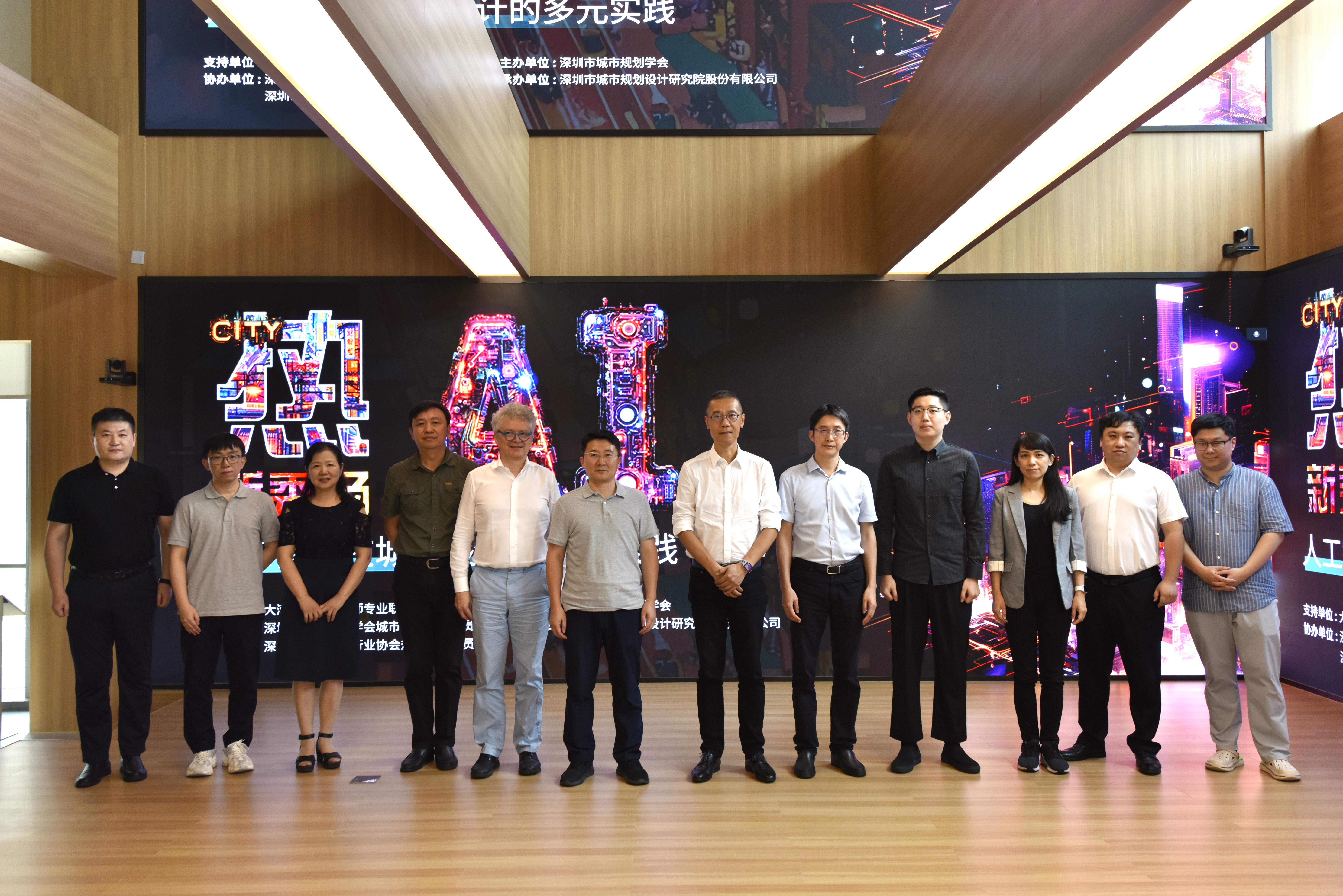

The Urban Planning Society of Shenzhen (UPSSZ) convened
the "AI Urban Design Showcase: Emerging Practices in the Greater Bay
Area" salon on August 9th at Shenzhen X- Institute, drawing 120+
planning professionals from Hong Kong, Guangzhou, Shenzhen, and Zhuhai for
intensive cross-border exchanges on AI-driven urban innovation.
Co-organized by the Greater Bay Area Urban Designers
Professional Alliance and hosted by UPSSZ, the salon featured technical
presentations, live demonstrations, and strategic dialogues centered on
integrating AI into urban design workflows.
UPSSZ Vice President Huang Weidong set the tone:
"We stand at an inflection point where AI redefines urban design's
boundaries. The challenge lies not just in adopting technology, but in
harnessing its transformative power to create livable, resilient cities."
Technical Breakthroughs Showcased
AIGC Image Tech: Revolutionizing Planning Workflows
He Songlun (Urban Planning & Design Institute of Shenzhen
) elaborated on how the institute leverages the open-source framework
Stable Diffusion for customized training and development of diffusion models,
aiming to enhance the practical effectiveness and efficiency of AIGC technology
in the field of urban planning and design. This approach achieves a harmonious
blend of precision and expressiveness in generating large-scale aerial
perspective renderings.
AI Optimization Methodologies in Urban Design
Dr. Zheng Hao (City University of Hong Kong) presented
breakthroughs achieved by his team in the field of AI-assisted urban
design. He positioned the computer as a design collaborator, integrating
big data on urban architectural layouts, crime rates, pedestrian activity
levels, and surface temperatures as AI training sets to achieve intelligent
generation and optimization of urban layouts. The AI model can further extend
its evaluation functions to precisely analyze urban characteristics such as
pedestrian accessibility, surface temperature regulation effects, and pandemic
transmission risks, providing a scientific basis for constructing safer and
more livable urban environments. This innovation not only improves design
efficiency but also enhances the scientific and predictive nature of urban
planning.
Cross-Domain Traffic Simulation & Intelligent Control
Wu Ruoqian (Shenzhen Transport Planning
Center) believes that while traffic simulation technology has a history
spanning decades, it is undergoing new transformations due to changes in demand
for refined and intelligent management, as well as the application of AI and
large models. China's urban transportation infrastructure is already globally
leading, but with a slowdown in investment scale, the current focus has shifted
to optimizing existing resources. Future transportation systems will be more
autonomous, with reduced human involvement, especially driven by the
development of autonomous vehicles and drones. Shenzhen Transport Planning
Center Co., Ltd. has developed TransSim, a fully autonomous and controllable
medium- and micro-scale traffic simulation software, demonstrating intelligent
expansion application cases for expressways, key corridors, important
districts, rail networks, and key hubs based on AI traffic agent construction
and simulation technologies.
Controllable LLM Strategies for Urban Planning Software
Dr. Huang Duo (South China University of Technology) ’s
sharing was mainly divided into three parts. The first part introduced the
latest progress and key technical features of large language models. The second
part elaborated on how to construct application strategies for controllable
large language models from perspectives such as technical vision, overall
strategy, and multi-dimensional technical strategies, based on discussing the
dilemmas faced by urban planning. The third part discussed the development of a
large language model software system that integrates technologies such as NLP,
RAG, PE, Agent, and LLM generation, based on the establishment of a local
knowledge base, targeting functions such as planning text archive management,
semantic vector library management, comprehensive retrieval, basic and advanced
intelligent language model applications, and comprehensive text generation.
AI-Social Intelligence Synergy: Future Scenarios
Dr. Yuan Xiaohui (Tencent Research Institute) proposed
that we are at a node of intellectual transformation, where intellectual
resources have become a service accessible to everyone. Against this backdrop,
he introduced Tencent's attempts and efforts in relying on urban spaces to
enhance social computing power and promote technological innovation, proposing
that urban spaces are the value carriers in the AI era and introducing the
concepts of social intelligence and social computing power. Based on the
viewpoint that "the evolution of urban form is also a process of
continuously enhancing social computing power," he presented three
possible future scenarios for human society: AI empowering various industries,
comprehensive employment replacement, and moving towards human-machine
symbiosis.
AI-Driven Collaborative Urban Innovation Paradigms
Liu Long (LAY-OUT Planning Consultants Co., Ltd) taking
six product projects of LAY-OUT as examples, Liu Long explored the practical
R&D work of achieving "four reshapings" in AI+ industries and
"everyone creating beautiful cities" in AI+ cities through AI
technology enhanced by professional knowledge and vertical models in the
planning industry. He proposed moving beyond the ivory tower of the industry,
facing the public, and using action-initiated planning to cope with the active
growth of urban value, meet the needs of refined urban management and planning
and design, and promote the digital transformation of planning and design.
Expert Critiques
Dr. Yuan Xiaohui, commented on the first two
presentations, stating, "He Songlun demonstrated how AIGC can be applied
to generate renderings in planning and design to assist practical work,
providing a best practice case that has been successfully implemented. She
also explored the role relationship between AI and designers, which holds
significant implications for future promotion and replication. Dr. Zheng Hao's
presentation showcased a methodology based on urban data, transforming
interesting propositions into quantifiable and assessable scientific questions,
helping us re-understand cities and discover patterns. The combination of these
two approaches provides valuable insights for the application of AI and science
in urban research."
Alain Chiaradia, Honorary Associate Professor at the
University of Hong Kong and Deputy Director of the Department of Urban Planning
and Design at the University of Hong Kong, commented on the presentations by Wu
Ruoqian and Dr. Huang Duo. "The above two excellent presentations offer
starkly different perspectives. The first speech focuses on transportation,
showcasing concepts such as transportation service levels, the value of time,
and free flow. In the past, people considered transportation a waste of time,
but now with technological advancements, the value of time spent traveling has
become more complex. The next challenge lies in enhancing journey quality, not
just shortening travel time. The second speech explores the holistic and
complex nature of urban planning and design, emphasizing the importance of
using technologies like AI to address planning challenges. I would also like to
introduce a new challenge for everyone to ponder: How do we rethink urban
planning from a people-centric perspective in the future? Do traditional
planning and design methods need to be overturned? How do we integrate the
experiences of urban residents into planning and design?"
Zhao Pengjun (Academician of the Academy of Social Sciences
in the UK, Dean and Professor of the School of Urban Planning and Design at
Peking University, and Vice President of the Urban Planning Society of
Shenzhen) commented, "The urban planning industry is at a critical period
of transformation, with the introduction of AI serving as an important driving
force for this transformation. However, the underlying power source
(spontaneous innovation or passive adaptation) behind this transformation still
needs to be clearly defined. Meanwhile, industry standardization and
replicability have become urgent issues to be addressed. The existing standards
and technologies have limited capabilities for popularization and replication,
and there is an urgent need to establish unified standards and promote scenario
integration. In response to the challenges brought about by new technologies,
such as the digital divide and the effectiveness of technology guidance, the
industry has generally recognized the importance of unified standards. To this
end, all parties should strengthen cooperation, implement precise measures,
promote the formulation and implementation of industry standards, ensure the
efficient and widespread application of AI technology in urban planning, and
jointly promote the healthy development of this field."
During the open exchange session, the guests took turns
sharing their insights and expectations regarding the development of AI and the
urban planning and design industry. The audience actively posed questions and
exchanged ideas with the guests on topics such as the evaluation mechanism for
AI, the integration of AI in education, and the application of AI in the
planning and design of Dachan Bay in Shenzhen, creating a lively atmosphere at
the venue.
At the close of the event, Deputy Secretary-General Sun
Yuehua highlighted that this year marks the 30th anniversary of the Shenzhen
Urban Planning Society, and this event serves as a remarkable part of the
society's series of academic celebrations. By the end of this year, Shenzhen,
as the rotating host city of the Greater Bay Area Urban Designers Alliance for
the 2023-2024 term, will organize the Greater Bay Area International Urban
Design Conference and plan more diverse academic exchange activities. Stay
tuned for more exciting developments.